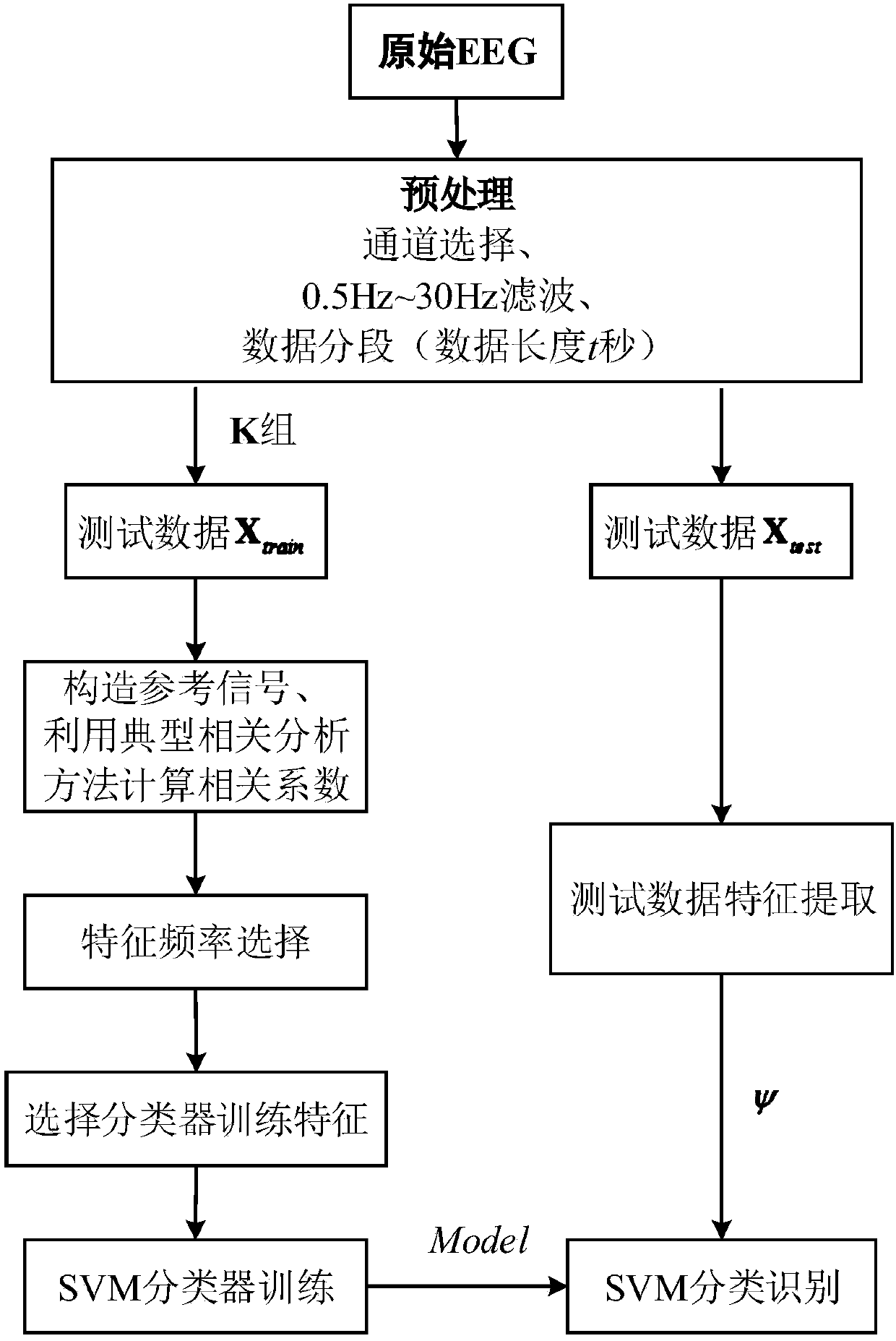Canonical correlation analysis-based electroencephalogram alpha wave detection and identification method
A technology of canonical correlation analysis and recognition method, applied in the field of EEG alpha wave detection and recognition based on canonical correlation analysis, can solve problems such as not suitable for fast detection, low detection efficiency, long signal duration, etc., to reduce the amount of calculation, Effects of rapid detection recognition, improved speed and accuracy
- Summary
- Abstract
- Description
- Claims
- Application Information
AI Technical Summary
Problems solved by technology
Method used
Image
Examples
Embodiment 1
[0030] At present, the method of energy analysis is mainly used in the detection and identification of EEG α waves. When the amplitude of EEG signals exceeds a threshold within a period of time, the signal will be considered as an α wave signal. This type of method requires a long duration of the signal, which is not suitable for a brain-computer interface system that requires fast detection and recognition. The present invention specifically studies a method for detecting and identifying EEG alpha waves based on canonical correlation analysis, see figure 1 , including the following steps:
[0031] (1) Input original EEG signals, including EEG α-wave signals and EEG non-α-wave signals.
[0032] (2) Preprocessing the original EEG signal: select the data of the four EEG signal channels Cz, CPz, Pz, and POz, perform a band-pass filter of 0.5 Hz to 30 Hz on the selected data, and then segment the data, The time length of each segment of data is t seconds, and after segmentation,...
Embodiment 2
[0048] The method for detecting and identifying EEG alpha waves based on typical correlation analysis is the same as in embodiment 1, the selection of different frequency sets described in step (3) and the reference signals corresponding to the construction of different frequencies, specifically including as follows:
[0049] (3.1) Select different frequency sets F ref : Frequency selection is carried out with a certain step size δ as an interval within 8Hz~13Hz, and N frequencies are obtained, that is, N=(13-8) / δ+1=5 / δ+1, and N frequency combinations form different frequency sets F ref .
[0050] In this example, the step size δ is selected as 0.2Hz, then N=(13-8) / 0.2+1=5 / 0.2+1=26, so different frequency sets F ref Consists of 26 frequencies.
[0051] (3.2) Construct reference signals corresponding to different frequencies: for different frequency sets F ref frequency f in i , construct f i Corresponding sine-cosine reference signal The construction method is as follow...
Embodiment 3
[0056] The EEG alpha wave detection and identification method based on canonical correlation analysis is the same as embodiment 1~2, the feature frequency selection described in step (5), see figure 2 ,Special attention figure 2 The last three steps in the process include the following:
[0057] (5.1) Calculation of different frequency sets F ref middle frequency f i Corresponding classification accuracy Extract the frequency f from the set of correlation coefficients Ω i Corresponding correlation coefficient, take a part of the correlation coefficient as the training sample, and another part of the correlation coefficient as the test sample, use the support vector machine (SVM) to analyze the frequency f i The corresponding correlation coefficients are trained and tested to obtain the frequency f i Corresponding classification accuracy
[0058] In this example, the frequency set F ref The number of intermediate frequencies is 26, f i Corresponding classification ...
PUM
 Login to View More
Login to View More Abstract
Description
Claims
Application Information
 Login to View More
Login to View More - R&D
- Intellectual Property
- Life Sciences
- Materials
- Tech Scout
- Unparalleled Data Quality
- Higher Quality Content
- 60% Fewer Hallucinations
Browse by: Latest US Patents, China's latest patents, Technical Efficacy Thesaurus, Application Domain, Technology Topic, Popular Technical Reports.
© 2025 PatSnap. All rights reserved.Legal|Privacy policy|Modern Slavery Act Transparency Statement|Sitemap|About US| Contact US: help@patsnap.com



